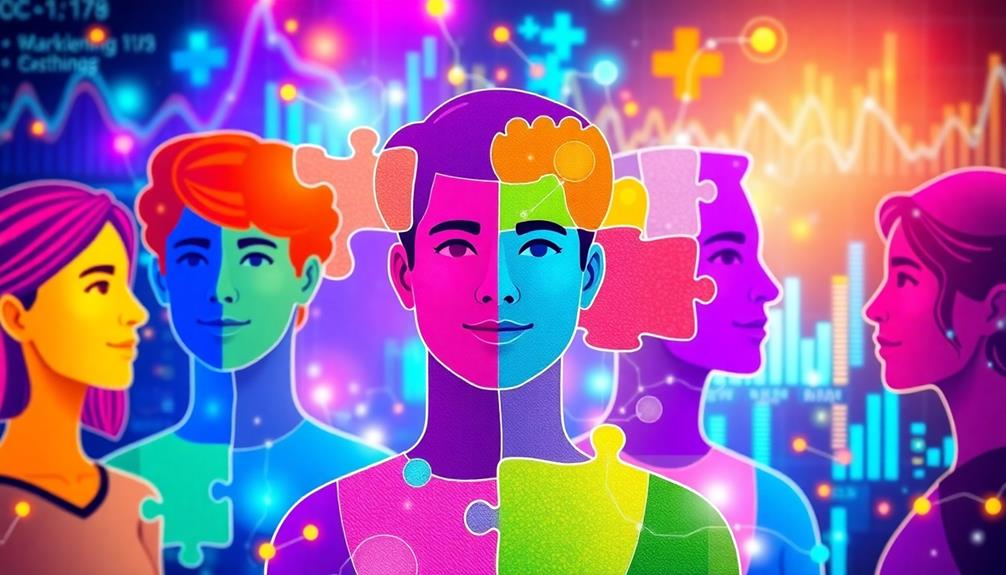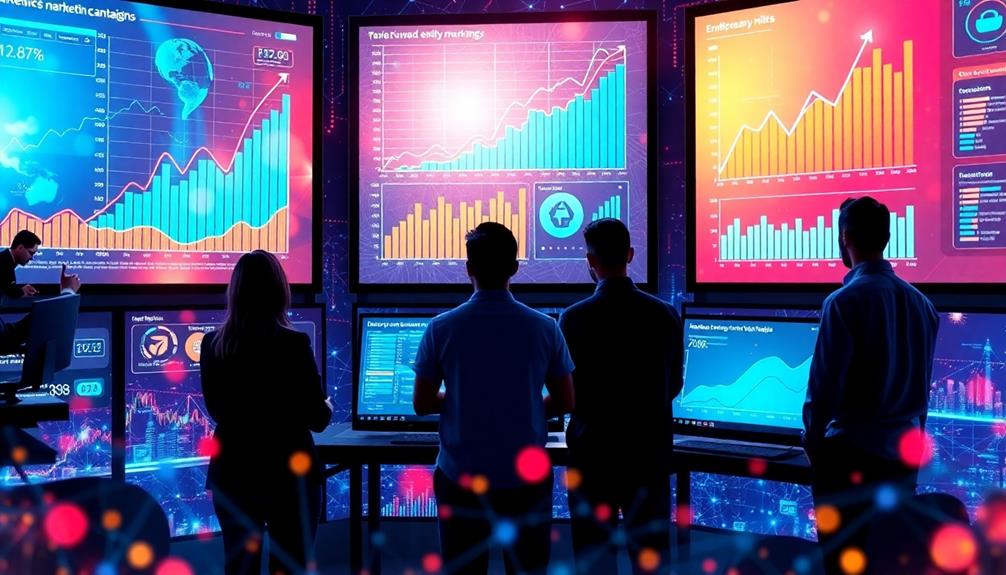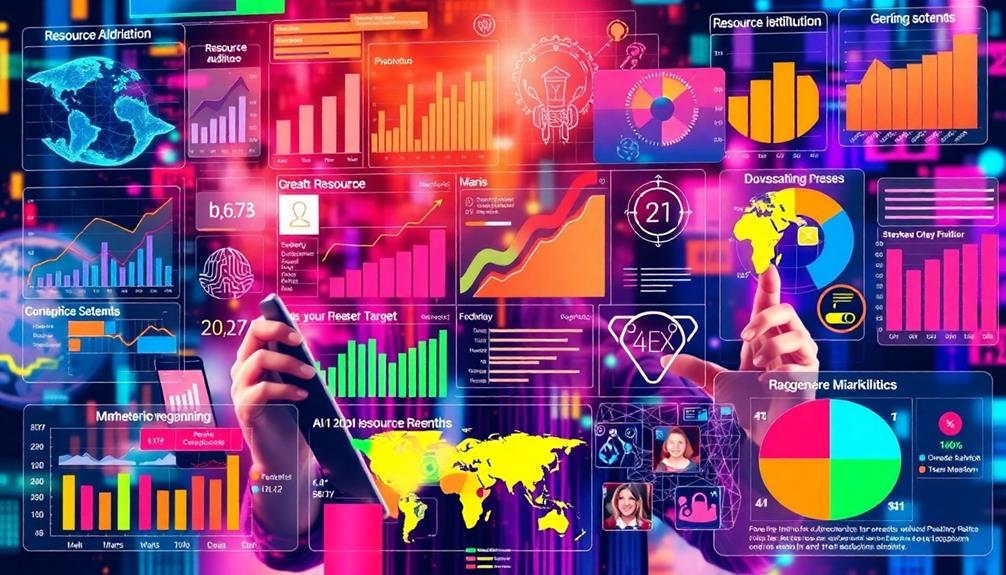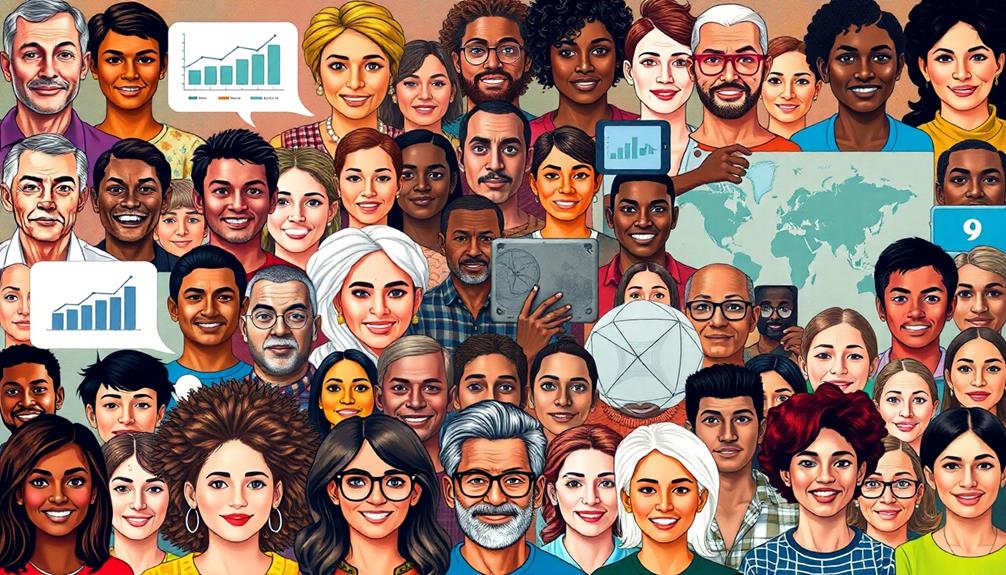You can leverage AI for predictive analytics in marketing in several impactful ways. First, enhance customer segmentation by analyzing purchasing behaviors and preferences. Next, optimize your marketing campaigns with real-time data to boost engagement. You can also predict sales trends with remarkable accuracy, allowing targeted advertising. Personalizing customer experiences is essential too; use AI to tailor marketing messages that resonate with individual preferences. Finally, improve resource allocation by automating budget assessments and identifying underperforming campaigns. These strategies are just the beginning of what AI can do for you. Stay tuned for deeper insights on maximizing your marketing impact!
Key Takeaways
- Utilize AI to analyze historical campaign data and identify effective marketing channels for improved budget allocation and ROI.
- Implement machine learning algorithms to segment audiences based on predicted behaviors, enhancing engagement rates significantly.
- Leverage real-time data processing to make instant adjustments to marketing strategies, improving conversion rates and sales performance.
- Use predictive analytics to forecast future sales trends and adjust marketing efforts accordingly for targeted advertising.
- Automate customer churn predictions with AI to proactively address potential losses and retain high-value segments.
Enhance Customer Segmentation

AI greatly enhances customer segmentation, making it easier for marketers to identify and target specific groups. By leveraging predictive analytics, you can analyze vast datasets to uncover distinct segments based on purchasing behavior, preferences, and demographics. This precision allows you to tailor your marketing strategies more effectively.
Focusing on a positive mindset, as emphasized in Abraham's Business Success Principles, can further guide your approach to connecting with these segments.
Using machine learning algorithms, these segments can dynamically adjust in real-time, ensuring your marketing remains relevant as consumer behavior evolves. Psychographic segmentation, enabled by AI, categorizes customers based on traits, values, and lifestyles. This approach provides deeper insights, helping you create more personalized marketing campaigns that resonate with your audience.
Additionally, event-triggered segmentation analyzes customer reactions to specific brand activities. This capability facilitates immediate and tailored marketing responses, enhancing engagement and improving customer experiences.
By integrating these advanced techniques into your data analysis, you can better allocate resources to high-potential segments, optimizing your marketing spend.
In today's competitive landscape, harnessing AI for customer segmentation isn't just an advantage; it's essential for effective personalized marketing. By embracing these innovations, you'll be well-equipped to connect with your customers in meaningful ways.
Optimize Marketing Campaigns

With enhanced customer segmentation in place, optimizing your marketing campaigns becomes the next logical step. By leveraging AI predictive analytics, you can analyze historical campaign data to identify the most effective marketing channels. This allows you to allocate your budget more efficiently and optimize ROI by up to 30%.
Using machine learning algorithms, you can segment your audience based on predicted behaviors, leading to tailored messaging that boosts engagement rates by as much as 50%.
Furthermore, real-time data processing empowers you to adjust campaigns on-the-fly. This immediate responsiveness to consumer trends can improve your conversion rates by 20%.
Advanced predictive models can also forecast customer lifetime value, helping you prioritize high-value customers and enhance retention strategies, potentially increasing profitability by 25%.
Additionally, AI-driven insights refine your ad targeting, ensuring you reach the right audience at the right time. Campaigns utilizing predictive analytics often see up to a 40% reduction in customer acquisition costs.
Predict Sales Trends

Predicting sales trends is essential for businesses looking to stay ahead in a competitive market. By leveraging predictive analytics, you can analyze historical data to identify patterns and forecast future sales trends with up to 95% accuracy. This empowers you to make informed decisions about inventory and resource allocation.
Additionally, the utilization of data analytics for targeted advertising can further enhance your marketing efforts, allowing you to reach the right audience effectively.
Utilizing machine learning algorithms, you can enhance customer segmentation based on buying behavior and preferences. This enables you to develop tailored promotions that can boost sales by 20% or more during peak seasons.
With real-time data processing, you can adjust your marketing strategies instantly, responding to market changes and consumer demands, potentially leading to a 15% improvement in sales performance.
Moreover, predictive models can assess the impact of external factors, such as economic indicators, helping you anticipate fluctuations in sales. Companies that harness AI for predicting sales trends report a reduction in forecasting errors by up to 30%, which enhances operational efficiency and profitability.
This proactive approach allows you to adapt your marketing strategies effectively, ensuring you remain competitive in today's dynamic marketplace.
Personalize Customer Experiences

Personalizing customer experiences is a game changer for today's marketers. By utilizing AI-powered predictive analytics, you can analyze customer behavior patterns and tailor personalized marketing messages that resonate with your audience. This approach has been shown to boost engagement rates by 20%.
Additionally, understanding consumer preferences can lead to improved health and wellness choices, as many customers are increasingly aware of the quality of products they consume and use in their homes, such as health benefits of air purifiers.
Leveraging AI algorithms allows your business to predict individual customer preferences and optimize product recommendations, leading to a remarkable 30% improvement in conversion rates. Furthermore, predictive models help in effective segmentation based on psychographic data, enabling you to craft targeted campaigns that align with specific consumer values and lifestyles.
With AI, you can automate the analysis of customer interactions across various platforms, facilitating real-time adjustments to your marketing strategies. This agility enhances customer experience, making your outreach more relevant and impactful.
Additionally, predictive analytics can anticipate customer churn, allowing you to proactively implement retention strategies that could reduce churn rates by up to 15%.
Incorporating these practices not only improves your customer experience but also notably impacts your overall profitability. By focusing on personalized marketing, you're setting the stage for long-term success.
Improve Resource Allocation

As businesses endeavor to maximize their marketing impact, leveraging AI for predictive analytics can greatly enhance resource allocation. By utilizing machine learning algorithms, you can analyze historical spending patterns to pinpoint the most effective channels for investment. This enables you to allocate resources more efficiently, ultimately maximizing your return on investment.
Real-time data analysis allows you to quickly identify underperforming campaigns, facilitating timely adjustments in budget allocation to focus on high-performing strategies. With predictive models forecasting customer lifetime value (CLV), you can prioritize high-value segments, ensuring that your marketing budgets are directed where they'll yield the greatest returns.
AI also automates budget pacing assessments, aligning your spending with projected outcomes and optimizing resource allocation throughout the marketing campaign lifecycle.
Frequently Asked Questions
How Can AI Be Used in Predictive Analytics?
AI's used in predictive analytics by analyzing vast datasets to identify patterns, forecast trends, and optimize decision-making. It helps you enhance customer segmentation, assess lifetime value, and make data-driven adjustments for better results.
How Is AI Used in Marketing Analytics?
AI's revolutionizing marketing analytics by analyzing vast datasets, identifying patterns, and predicting customer behavior. You can leverage these insights to tailor campaigns, enhance customer segmentation, and improve retention strategies, driving more effective marketing decisions overall.
What Is the Role of AI in Predictive Marketing?
AI's role in predictive marketing's essential. It analyzes historical data, identifies customer patterns, and forecasts behavior. You leverage these insights to tailor strategies, enhance engagement, and allocate resources effectively, maximizing your marketing impact and ROI.
How Can Predictive Analytics Be Used in Marketing?
Like a crystal ball, predictive analytics helps you foresee customer behavior by analyzing past purchase data. You can tailor marketing strategies, enhance engagement, and optimize ad spend, ensuring you get the best return on investment.
Conclusion
Incorporating AI into your marketing strategy is like planting a garden of insights, where each predictive analysis blooms into opportunities. By enhancing customer segmentation, optimizing campaigns, predicting sales trends, personalizing experiences, and improving resource allocation, you're not just staying ahead of the curve—you're dancing with it. Embrace these powerful tools, and watch as your marketing efforts flourish, turning data into a vibrant tapestry of success that captivates your audience and drives growth.










